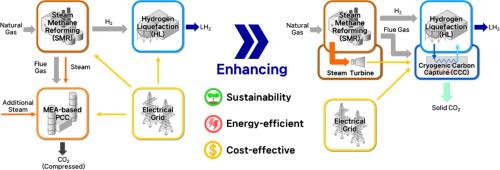Cryogenic carbon capture as the bridge for integrating hydrogen production and Liquefaction: Enhancing the sustainability of blue hydrogen Production-to-Storage systems
IF 13.3
1区 工程技术
Q1 ENGINEERING, CHEMICAL
引用次数: 0
Abstract
Hydrogen is one of the promising energy vectors for sustainable energy systems because of its carbon-free combustion and high mass-energy density. However, most hydrogen production processes remain carbon-intensive, and the low volumetric energy density of hydrogen significantly hinders storage efficiency. To reduce carbon emissions during hydrogen production, amine-based chemical absorption methods are commonly employed. However, these methods face challenges, such as low capture efficiency and high energy demands. To improve storage efficiency, hydrogen liquefaction methods have been explored to reduce volume. Nevertheless, liquefaction methods require cryogenic operating temperatures, which result in high power consumption and substantial cost burdens. To address these issues, this study proposes a novel system that integrates hydrogen production and liquefaction processes by introducing cryogenic carbon capture (CCC). In the proposed system, CCC obtains cold energy through integration with the precooling cycle of the hydrogen liquefaction process, eliminating the need for additional refrigeration units. Consequently, the integrated system achieves a 99.99% carbon capture rate, with a 27.5% reduction in overall energy consumption. Moreover, the economic feasibility increased by 7.87%, and the CO2 avoidance cost decreased by 58.5%. The carbon-techno-economic analysis results revealed that the carbon capture penalty can be offset at 52.5% lower carbon tax rates. Additionally, scenario studies revealed that the proposed system demonstrates 41.9% higher economic performance than liquefied green hydrogen systems while maintaining comparable environmental benefits.

低温碳捕集作为整合氢气生产和液化的桥梁:增强蓝色氢气生产到储存系统的可持续性
氢因其无碳燃烧和高质能密度而成为可持续能源系统中很有前途的能源载体之一。然而,大多数制氢过程仍然是碳密集型的,氢的低体积能量密度严重阻碍了储存效率。为了减少制氢过程中的碳排放,通常采用胺基化学吸收方法。然而,这些方法面临着诸如低捕获效率和高能量需求等挑战。为了提高储存效率,人们探索了减少体积的氢液化方法。然而,液化方法需要低温操作温度,这导致高功耗和巨大的成本负担。为了解决这些问题,本研究提出了一种新的系统,通过引入低温碳捕获(CCC),将制氢和液化过程集成在一起。在提出的系统中,CCC通过与氢液化过程的预冷循环集成来获得冷能,从而消除了对额外制冷装置的需要。因此,集成系统实现了99.99%的碳捕获率,整体能耗降低了27.5%。经济可行性提高了7.87%,CO2减排成本降低了58.5%。碳技术经济分析结果显示,降低52.5%的碳税率可以抵消碳捕获惩罚。此外,情景研究表明,该系统的经济性能比液化绿色氢系统高出41.9%,同时保持了相当的环境效益。
本文章由计算机程序翻译,如有差异,请以英文原文为准。
求助全文
约1分钟内获得全文
求助全文
来源期刊

Chemical Engineering Journal
工程技术-工程:化工
CiteScore
21.70
自引率
9.30%
发文量
6781
审稿时长
2.4 months
期刊介绍:
The Chemical Engineering Journal is an international research journal that invites contributions of original and novel fundamental research. It aims to provide an international platform for presenting original fundamental research, interpretative reviews, and discussions on new developments in chemical engineering. The journal welcomes papers that describe novel theory and its practical application, as well as those that demonstrate the transfer of techniques from other disciplines. It also welcomes reports on carefully conducted experimental work that is soundly interpreted. The main focus of the journal is on original and rigorous research results that have broad significance. The Catalysis section within the Chemical Engineering Journal focuses specifically on Experimental and Theoretical studies in the fields of heterogeneous catalysis, molecular catalysis, and biocatalysis. These studies have industrial impact on various sectors such as chemicals, energy, materials, foods, healthcare, and environmental protection.
 求助内容:
求助内容: 应助结果提醒方式:
应助结果提醒方式:


